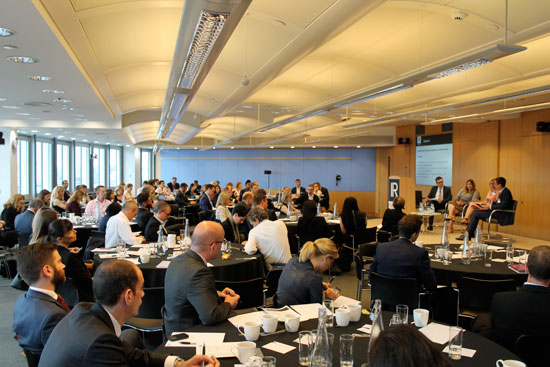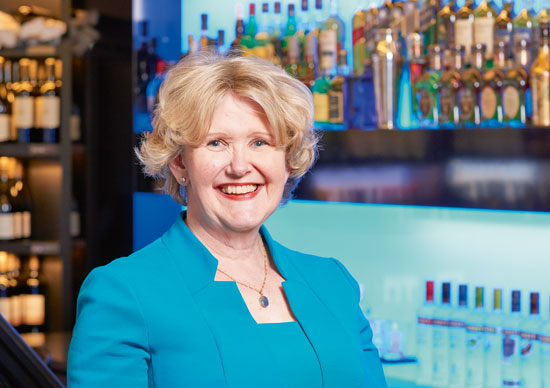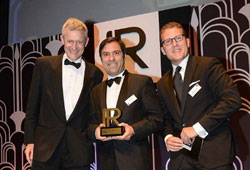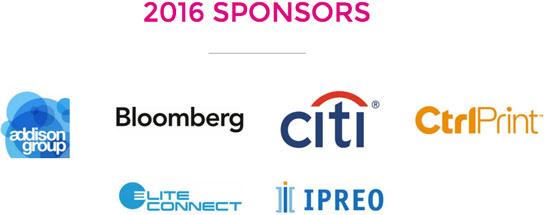IROs chewed over Brexit, Mifid II and squeezed resources at the think tank for senior European IR professionals
|
At a glance |
Few thought the UK would vote to leave the European Union. Not the majority of politicians, not the majority of media pundits ‒ and not any of the IROs who attended the IR Magazine Think Tank – Euro Leaders 2016, held in London on the day before the vote. In a straw poll of the audience, everyone thought the Remain campaign would win.
The first session of the think tank conveniently focused on macroeconomic issues, allowing the room to tackle the referendum from the get-go. ‘Brexit in particular is highly uncertain,’ said one investor. ‘I’ve been doing this for 25 years and I’ve never felt quite as tentative as I feel right now about the next 48 hours. And that must be true for most of your businesses.’
From an IR perspective, companies should be thinking about what they can say on the variables that will be affected by the vote, such as currency exposure, regulation and access to European markets, he added. These ‘jigsaw pieces’ will help your investors put together the picture they need.

IR Magazine Think Tank – Euro Leaders 2016
One IRO had just returned from a roadshow to the US. He said stateside investors, which make up 40 percent of his shareholder base, had been selling European equities in the run-up to the referendum. ‘We are not going to stem the flow away from European equities,’ he said. ‘Our role in the US is to tell the long-term story so if they come back into equities they come back into our company rather than somewhere else.’
Catching the wind with Diageo

Diageo's Catherine James
In a change to the format of this year’s think tank, IROs heard short best practice case studies from IR professionals ranked highly by IR Magazine’s surveys of investors and analysts. In the first, Catherine James, head of IR at Diageo and an IR veteran of almost 20 years, said IR is really very simple in what we need to achieve – but it’s not easy to pull it off. James, a sailor in her spare time, said the buzz of the job comes from that feeling of the ‘wind in the sails’ when a meeting or event couldn’t have gone any better.
What makes great IR? James broke it down into seven key areas (notice that the third point accounts for when the direction of the wind shifts unexpectedly):
• Know your business
• Know your audience
• Anticipate change
• Build a service mentality
• Build strong internal links
• Build strong stakeholder relationship
• Be consistent on timing, format and data.
Such situations truly ‘test the mettle’ of IR, because you need to have a very clear understanding of your business, continued the IRO. ‘The other thing you have to be really clear about is what you don’t know. You have to get really comfortable saying, I can’t answer that question at this point in time. I’m not even going to afford you a view because [that might] fuel ambiguity on ambiguity.’
After exhausting Brexit, the conversation moved on to other macro factors. A couple of attendees noted how your business may be exposed to issues you weren’t aware of. One example: a manufacturer of medical devices might not pay too much attention to the price of oil. But a fall in oil price leads to a drop in the amount of construction work. That in turn results in fewer construction site injuries, hitting the market for trauma equipment.
Mifid II briefing
Regulation featured next on the agenda with a briefing on Mifid II. Even here Brexit got a mention, given that the UK has been the voice within Europe pushing for the most aggressive changes within the legislation.
Under Mifid II, fund managers will have to pay for research in one of two ways: out of their own costs or through a research payment account agreed in advance with the client. This will be a 'seismic' change for the buy side and one that hasn't happened anywhere else in the world.
For listed companies, the result could be a drop in research coverage. The new regime will encourage fund managers to absorb research costs themselves, which is expected to lead to deflationary pressure on payments. ‘We are already seeing some of the significant dealers reduce their coverage,’ said one attendee.
While smaller companies may fret about the loss of coverage, larger issuers are less likely to mind and could even welcome a trimming of their analyst numbers. Europe has a lot of companies that appear overbroked compared to their US counterparts, it was noted.
An unintended consequence of the legislation could be that IR teams find it harder to access research reports through news and data platforms. That’s because brokers will need to be careful how they make their research available, to ensure they are not falling foul of Mifid II rules on inducements.
Turning to corporate access, some predict Mifid II could restrict brokers' ability to provide support in this area. Others, however, are confident this will not be the case given the wording of the legislation. In any case, brokers will still be able to provide services defined as research to investors under the new Mifid II payments system.
The changes being wrought on the sell side are not just a result of new legislation but a confluence of factors, it was highlighted. Since the financial crisis, there has been a big fall in the size of the commission wallet thanks to trends like the growth of passive investment and electronic trading. This fall will continue with Mifid II as investors are forced to think more carefully about how and where they allocate their money.
Running lean
In advance of each think tank, IR Magazine polls IROs to find out what subjects to tackle. One subject that received plenty of mentions was how to make the most of scarce resources. It seems a large number of companies are currently grappling with squeezed finances and downsized teams. At some companies, IR and corporate communications departments are working more closely together or even merging, the audience heard. Partly that’s because companies want to better align their communications with various stakeholders, but it also helps the organization to cut costs.
Getting the measure of EDP

EDP's Miguel Viana (center)
In the other best practice case study, Miguel Viana, head of IR at EDP and winner of many IR Magazine Awards, spoke to the audience about how his company measures IR performance. Using a mix of KPIs, Viana incorporates qualitative and quantitative information on investor outreach, as well as feedback from management on the quality of market intelligence provided by the IR team.
The weighting of each KPI is broken down in the following way:
• 30 percent: Feedback from analysts/investors on their perception of the quality of EDP’s IR service
• 20 percent: Accuracy of consensus of key sell-side forecasts (Ebitda, EPS and net debt)
• 15 percent: Volume of interactions with investors and analysts, covering all forms of contact from emails to roadshows
• 15 percent: Management feedback on inflow of information collected in the market
• 20 percent: Other, such as the execution of the IR department budget and European IR rankings
One company further reported a drop-off in interest from brokers (perhaps as a result of Mifid II, the IRO mused). In response, the firm has started to organize more roadshow activity in-house, including a recent two-day trip to New York. It managed to fill 80 percent of the schedule itself, before asking a bank to help out with the final slots. The lesson? In large cities it’s quite possible for IR to pull this off.
Speakers offered many more tips for making the most of lean resources, including:
• Consider smaller capital markets days. They are less work for the IR team and senior management, and investors and analysts enjoy the intimate setting
• Cut activity that isn’t a priority. International site visits were all the rage a few years ago, but do you really need one? Investors have smaller budgets for travel now anyway
• See what free tools are available online. You may be able to swap expensive data services with alternatives like Yahoo Finance. In addition, use complimentary events and reports to train up team members
• Consider virtual meetings to save travel costs and extend your reach. Some investors will send one analyst to a meeting while the rest of the team joins via teleconference.
Digital disrupters and speed discussions
The afternoon included a session on the digitization of IR, where the audience heard about new tools helping IROs boost their effectiveness in areas such as corporate access, targeting and annual reports. It was then on to the day’s final session: speed-discussion topics. The set-up was six tables, each with its own topic and discussion leader. At certain times, attendees could switch tables, allowing them to pick the subjects of most interest.
One group discussed reporting trends. Companies should be thinking about how they communicate alternative performance measures (APMs), the table was told, following the introduction of new Europe-wide guidelines in July. When using APMs, issuers need to make sure they are disclosed and reported properly so investors can make adjustments as needed. The group also discussed how to report on executive pay. Some companies now include at-a-glance pages in their annual reports to help buy-siders who are not compensation experts (or just don’t want to read 10+ page remuneration reports).
At another table, IROs heard about how stock markets are being increasingly buffeted by money invested through quant strategies. One type, factor investing, which focuses on the underlying drivers of risk and return, has grown four-fold over the last decade. For IROs, it is a question of awareness. With huge sums of money invested in these strategies, they can cause big movements in individual stocks. Your recent price swing could be the result of inclusion in an exchange-traded fund you don’t even know about. That question IR professionals hear so frequently – what’s going on with the stock? – continues to grow in complexity.











